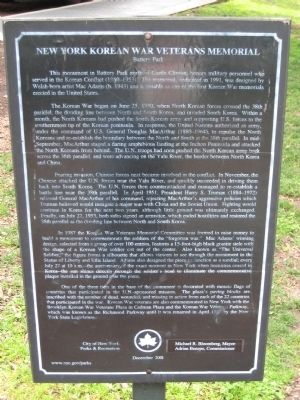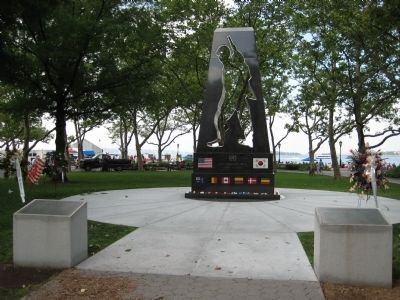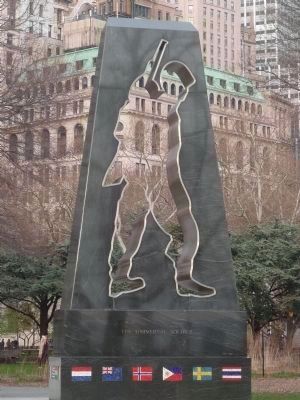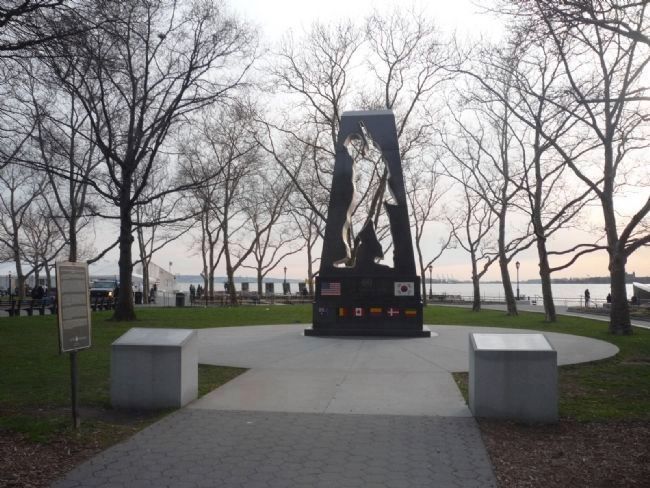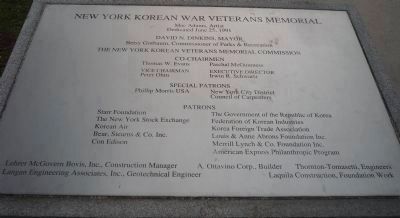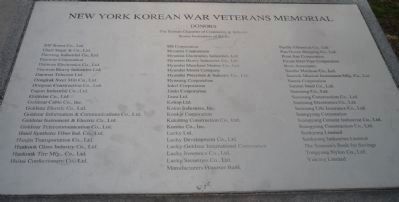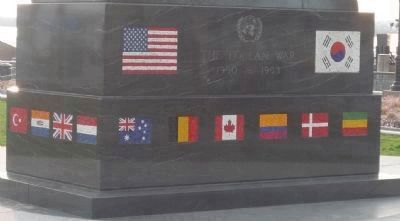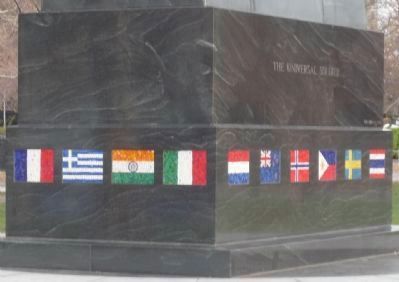Battery Park in Manhattan in New York County, New York — The American Northeast (Mid-Atlantic)
New York Korean War Veterans Memorial
Battery Park
The Korean War began on June 25, 1950, when North Korean forces crossed the 38th parallel, the dividing line between North and South Korea, and invaded South Korea. Within a month, the North Koreans had pushed the South Korean army and supporting U.S. forces to the southernmost tip of the Korean peninsula. In response, the United Nations authorized an army under the command of U.S. General Douglas MacArthur (1880-1964), to repulse the North Koreans and re-establish the boundary between the North and South at the 38th parallel. In mid-September, MacArthur staged a daring amphibious landing at the Inchon Peninsula and attacked the North Koreans from behind. The U.N. troops had soon pushed the North Korean army back across the 38th parallel, and were advancing on the Yalu River, the border between North Korea and China.
Fearing invasion, Chinese forces next became involved in the conflict. In November, the Chinese attacked the U.N. forces near the Yalu River, and quickly succeeded in driving them back into South Korea. The U.N. forces then counterattacked and managed to re-establish a battle line near the 38th parallel. In April 1951, President Harry S. Truman (1884-1972) relieved General MacArthur of his command, rejecting MacArthur's aggressive policies which Truman believed would instigate a major war with China and the Soviet Union. Fighting would continue in Korea for the next two years, although little ground was ultimately exchanged. Finally, on July 27, 1953, both sides signed an armistice, which ended hostilities and restored the 38th parallel as the dividing line between North and South Korea.
In 1987 the Korean War Veterans Memorial Committee was formed to raise money to build a monument to commemorate the soldiers of the "forgotten war". Mac Adams' winning design, selected from a group of over 100 entries, features a 15-foot-high black granite stele with the shape of a Korean War soldier cut out of the center. Also known as "The Universal Soldier," the figure forms a silhouette that allows viewers to see through the monument to the Statue of Liberty and Ellis Island. Adams also designed the piece to function as a sundial; every July 27 at 10 a.m. - the anniversary of the exact moment in New York when hostilities ceased in Korea - the sun shines directly through the soldier's head to illuminate the commemorative plaque installed in the ground near the piece.
On of the three tiers in the based of the monument is decorated with mosaic flags of countries that participated in the U.N.-sponsored mission. The plaza's paving blocks are inscribed with the number of dead, wounded, and missing in action from each of the 22 countries that participated in the war. Korean War veterans are also commemorated in New York with the Brooklyn Korean War Veterans Plaza in Cadman Plaza and the Korean War Veterans Parkway, which was known as the Richmond Parkway until it was renamed in April 1997 by the New York State Legislature.
Erected 2001 by City of New York Parks & Recreation.
Topics and series. This memorial is listed in this topic list: War, Korean. In addition, it is included in the Former U.S. Presidents: #33 Harry S. Truman, and the NYC Parks series lists.
Location. This marker has been replaced by another marker nearby. It was located near 40° 42.245′ N, 74° 1.022′ W. Marker was in Manhattan, New York, in New York County. It was in Battery Park. Memorial could be reached from Battery Place near West Street. Marker is about 300 feet from the intersection, in the direction of Castle Clinton. Touch for map. Marker was in this post office area: New York NY 10004, United States of America. Touch for directions.
Other nearby markers. At least 8 other markers are within walking
distance of this location. A different marker also named New York Korean War Veterans Memorial (here, next to this marker); a different marker also named New York Korean War Veterans Memorial (here, next to this marker); Norwegian Maritime Memorial (within shouting distance of this marker); The Lives of Castle Clinton: (within shouting distance of this marker); Battery Wall Discovery (within shouting distance of this marker); History of the Battery Wall (within shouting distance of this marker); History of Pier A (within shouting distance of this marker); Emma Lazarus (within shouting distance of this marker). Touch for a list and map of all markers in Manhattan.
Related marker. Click here for another marker that is related to this marker. This marker was replaced by a similarly titled NYC Parks marker.
Also see . . . The Battery: New York Korean War Memorial. The official Parks Department description of the monument. (Submitted on December 12, 2018, by Larry Gertner of New York, New York.)
Credits. This page was last revised on July 19, 2023. It was originally submitted on August 2, 2008, by F. Robby of Baltimore, Maryland. This page has been viewed 2,362 times since then and 48 times this year. Last updated on July 26, 2010, by William J. Toman of Green Lake, Wisconsin. It was the Marker of the Week June 30, 2013. Photos: 1, 2. submitted on August 2, 2008, by F. Robby of Baltimore, Maryland. 3, 4, 5, 6, 7, 8. submitted on April 2, 2010, by Richard E. Miller of Oxon Hill, Maryland. • Kevin W. was the editor who published this page.
